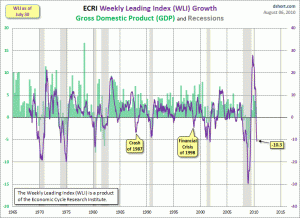Home » Posts tagged 'business cycle'
Tag Archives: business cycle
What’s been holding back the recovery
Jim Hamilton shares his insights into a puzzling question: housing sector accounts for less than 5% of the total economy, yet why it, along with auto sector, tends to drive the US business cycle.
Two of the most important sectors in U.S. business cycle fluctuations are autos and housing. For example, in the 2007:Q4-2009:Q2 recession, real GDP fell on average at a 2.7% annual rate, with autos and housing accounting for about half of this decline all by themselves.
… Although autos and housing make a very significant contribution to changes in GDP growth rates over the business cycle, they represent only a small part of the level of total GDP. Over 1947-2011, spending on motor vehicles and parts only amounted to 3.5% of total GDP on average, while housing was less than 4.7%. But the fluctuations in spending on new cars and homes are so volatile, these percentages change quite a bit over the cycle, rising well above average during expansions and falling in contractions. For 2011:Q3, motor vehicles and parts represented 2.4% (or close to 30% drop) of the level of GDP, while residential fixed investment was only 2.2% (more than 50% drop).
The fact that the levels remain so low today relative to their historical averages means that housing construction and automobile manufacturing have fallen well below what’s needed to keep up with growing population. That suggests the potential for a significant positive contribution from these two sectors if the recovery could ever get back on track.
Read the full post here.
How recession in debt deleveraging cycle different?
We’re in a time of unusual economic uncertainties.
David Rosenberg thinks, in the following video discussion, that this recession is fundamentally different from post-war recessions. The difference is this severe recession is coupled within a secular cycle of credit contraction.
While others think the US is in a subdued period of economic growth. Once unemployment starts getting better, and household gradually improves their balance sheets, with huge corporate cash piled up waiting to be invested, it’s a matter time that American economy will be back on track.
A lively discussion – don’t miss this one:
Business cycle indicator says double-dip is likely
ECRI WLI index says there is a fair chance that double-dip is coming. Here is an analysis I borrowed from dshort.com.
(click to enlarge; graph courtesy of dshort.com)
According to dshort:
A significant decline in the WLI has been a leading indicator for six of the seven recessions since the 1960s. It lagged one recession (1981-1982) by nine weeks. The WLI did turned negative 17 times when no recession followed, but 14 of those declines were only slightly negative (-0.1 to -2.4) and most of them reversed after relatively brief periods.
Three of the false negatives were deeper declines. The Crash of 1987 took the Index negative for 68 weeks with a trough of -6.8. The Financial Crisis of 1998, which included the collapse of Long Term Capital Management, took the Index negative for 23 weeks with a trough of -4.5. The third significant false negative came near the bottom of the bear market of 2000-2002, about nine months after the brief recession of 2001. At the time, the WLI seemed to be signaling a double-dip recession, but the economy and market accelerated in tandem in the spring of 2003, and a recession was avoided.
The question, of course, is whether the latest WLI decline is a leading indicator of a recession or a false negative. The index has never dropped to the current level without the onset of a recession. The deepest decline without a near-term recession was in the Crash of 1987, when the index slipped to -6.8.




